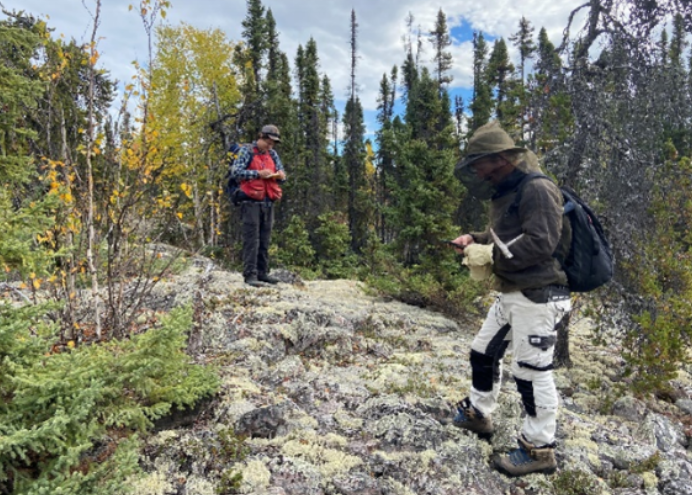Miners grapple with digital disruption

 Rick Howes, CEO of
Rick Howes, CEO of
Dundee Precious Metals;
Samantha Espley,
director of Vale Base
Metals’ Technical
Excellence Centre.
On Feb. 1, mining companies and mining suppliers gathered for the first Beyond Digital Transformation conference in Sudbury, Ont., to discuss the changing technological needs of mines and to network.
The conference was hosted by Partners in Achieving Change Excellence (PACE), a change management company.
“We decided to do this conference because we’ve been working with quite a few mining companies and were privy to their up and coming innovations and technological roadways,” said Nėha Singh, president and CEO of PACE. “There is a huge inflection of how mining companies are adapting technology right now and we know our supply and services sector have very successful companies. We want to know what the mining companies want.”
Representatives from four mining companies – Barrick Gold, Glencore, Vale and Dundee Precious Metals – gave presentations to the 260 people in attendance at the one-day event.
“I think it’s more about answering the question: Why should I need my organization transformed?” said Patrick Marshall, manager, automation projects, innovation, at Barrick Gold.
He noted that half the Fortune 500 or merged since 2000, saying that their demise came because they didn’t make changes in technology.
“What happened that they didn’t identify or respond to changes in technology?” Marshall asked. “We as an industry must be prepared to adapt, because whether we like it or not, disruption might be right around the corner.”
A clean slate
A new way of mining must be imagined.
“If we were to wipe the slate clean and rethink how we build a mine and operate mines – erase all the assumptions, redesign the system – I think we can put together a very different system,” Marshall said.
To make these changes, mining companies are looking for partners to work with in designing and implementing new technologies.
“From the mining site’s prospective, we have problems we needed to solve,” said Sean McCarthy, engineering superintendent at Barrick. “If you have a gap between what’s actual and what’s desired,
you have a problem.”
They discovered part of the problem was inefficient data handling.
“Everything we had was in Excel,” McCarthy said. “As good as (Excel spreadsheets) are, they are terrible for handling data. But they are our favourite crutch.”
The company recognized a shortfall in computer skills.
“We realized we needed to move quickly towards the digital frontier, and understand how we were going to use digitization to improve our mine,” said McCarthy.
Barrick tasked out equipment and jobs to people, until all of the people were busy and called it digital task assignment co-ordination. This system improved flexibility and reliability.
“Automation has changed a lot in the last ten years,” McCarthy said. “Deploying an automated system is a lot easier now.”
Samantha Espley, director of Vale Base Metals’ Technical Excellence Centre of Mining and Mineral Processing, addressed the business side of change.
“If we can transform our business in the sense of transforming the bottom line, then we are going to have a long term sustainable future,” Espley said. “It is something we are very much committed to.”
Vale operates five mines in Sudbury: Coleman, Creighton, Garson, Totten and Copper Cliff. Totten mine is the model for Vale. “This is the template we want to use for all the other mines to come in behind.”
But change isn’t always easy. As with Barrick Gold and Glencore, engaging the employees was critical, bringing together the IT department, operating department and capital projects team.
“There is lots of unnecessary waste, and I think this is what we are trying to control,” Espley said. “Get rid of the waste and the downtime and turn our mines around in terms of the rate we develop and mine.”
To control the waste, Espley believes data collection and relatability is key.
“We need to relate data much quicker than we do today and we need a tool to do that.” Espley said. “We need the seamless integration of all data.”
New technology must improve the production of a mine.
“It has to be clear in everyone’s head that we are not talking about putting in technical innovation for the technical innovation’s sake, it has to address the problem; it must provide a solution.”
Espley added that women will be a big part of the change.
“We have to improve to sustain the business, but we also see an opportunity to thrive, not just survive.”
The future of mining
The keynote speaker was Rick Howes, president and CEO of Dundee Precious Metals.
“I don’t think anyone can fully predict what the future of mining is going to look like,” he said. “I think there are a few signs and clues, if you stop to think about it, of what’s possible.”
He believes it’s up to the leadership within the mining industry to lead the way.
“I’m not talking about the operational mining companies,” Howes said. “It’s the entire ecosystem of mining which includes all of our suppliers, universities, governments and all the stakeholders.”
Technology, Howes said, is changing all businesses. He thinks the mining industry can use many of these new technologies: big data and advanced analytics, augmented and virtual reality, cloud computing and systems integration, advanced simulation, industrial internet of things, sensors, drones, machine learning and AI, advanced robotics, and chainblock technology. He believes these technologies will make the industry more flexible to market variations.
“The threat is that If you don’t move quickly enough to adapt, you risk becoming obsolete,” Howes said. “And the opportunity is that you transform the way you do things for better, safer, more efficient, sustainable mining.
“The new differentiators of mining companies will be in their ability to leverage data and to successfully adopt to technological change. Those who can leverage the data best, those who can adopt to the technological changes the fastest, are going to be the most successful mining companies.”
Kevin McAuley, manager of sustainable development and innovation at Glencore and Greg Sandblom, operations and business technology leader, Sudbury Integrated Nickel, Glencore also give a presentation.
“If you make it simple, you can get started,” McAuley said. “You can make great progress with very simple changes.”
Sandblom said one biggest problems and accomplishments was getting IT and operations to work together.
The next PACE conference will be held in early February 2019 and extended to two days.





Comments